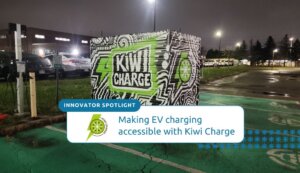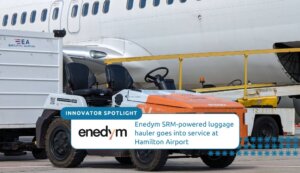SWTCH Energy Inc. has partnered with AutoGrid to balance electricity demand and reduce electrical bills by integrating 250 electric vehicle (EV) chargers in multi-tenant properties into an active demand response program with a Canadian utility.
SWTCH claims this is a first in North America.
The company did not disclose the name of the utility nor the location in which the chargers would be utilized. SWTCH utilizes 10 to 15 types of chargers from different brands, and has integrated Level 2 chargers with the utility.
Headquartered in Toronto with offices in Boston and Brooklyn, SWTCH provides electric vehicle charging solutions for multifamily and commercial properties across North America.
AutoGrid is a Redwood City, Calif.-based virtual power plant and distributed energy resources management system (DERMS) provider.
The technology behind the partnership
Sam Bordenave, SWTCH’s head of finance and strategy, told SustainableBiz the partnership with AutoGrid was built on a communication protocol called OpenADR. It is an open standard that ensures “if we integrate with other people using the same protocol, we’re going to receive the same messages.”
An initial interest in AutoGrid came from SWTCH’s interest in using OpenADR, which Bordenave said made it “really easy to do multiple integrations.
“We as a software company don’t have to come up with a lot of different bespoke integrations with other utilities or other DERMS,” Bordenave said.
The partnership took approximately six months to finalize and Bordenave believes SWTCH can replicate it with other DERMS providers in other utility programs.
How the SWTCH-AutoGrid partnership works
Bordenave explained there is a need for these programs with utilities and multiresidential units to help balance the power demand and lighten drivers’ electricity bills.
“It’s different from single-family home chargers, where most of the chargers that are deployed in single-family homes are not going to be connected (to each other),” Bordenave said. “Because it’s not one user, one house, one meter.
“So the utilities are working quite a bit to enroll these chargers into some sort of program because they realize that it’s going to be a big resource in the future.”
SWTCH provided its SWTCH Connect software, which allows other partners to interact with its assets. In this case, it interacts with AutoGrid’s AI-powered Flex platform.
Flex can process data from millions of energy assets simultaneously to forecast demand patterns, helping utilities automate distributed energy management. It manages over 6,000 megawatts of virtual power plants in 17 countries.
SWTCH EV chargers in AutoGrid’s demand response programs will be adjusted remotely for brief periods, helping manage demand on the electrical grid.
Demand response works in two ways: price-based programs, which use price signals and tariffs to incentivize consumers to use less electricity; and incentive-based programs that pay consumers directly. SWTCH and AutoGrid’s program will use the latter.
Customers will receive monthly incentive payments for participation. Eligibility is determined by participating in two “events” per month, according to Bordenave.
An “event” occurs when the utility sends signals to the chargers to lower their charge for a period of time. Drivers will be notified via app notifications, and can opt out at any time. The incentive works out to about $5 per event per charger.
“This is partly because, actually, the utility doesn’t know exactly how many events they’re likely to call. But also because we want to give a lot of flexibility to our drivers.”
SWTCH’s future with utilities
The global demand response market is expected to grow by approximately $1.4 billion between 2020 and 2025, led by North America, according to an August 2022 report by Technavio.
SWTCH’s goal is to have all of its chargers on some sort of utility program within two years.
“Anywhere that there’s either a utility program, or an electricity market where we can potentially leverage this demand response capability, we want to participate,” Bordenave said. “The goal is really, first and foremost, to give an added source of revenues for our drivers in order to make their charge more affordable.”
In October 2022, SWTCH partnered with Toronto-based Kite Mobility to implement vehicle-to-grid (V2G) charging with a Nissan Leaf at Tridel’s Bianca Condos in Toronto. The two-year pilot will evaluate the business case for SWTCH’s V2G and blockchain technology.
Bordenave also discussed the push from ride-sharing apps like Lyft and Uber requiring drivers to use EVs by 2030 as another reason to drive down the cost of charging with demand solutions.
“There are a lot of folks that are from less advantaged, or low and moderate income communities, that live in multifamily buildings,” he said. “So we really believe that we want to deploy chargers in these buildings to enable these people to tap in the EV revolution…and we want them to be able to charge in an affordable way.”








